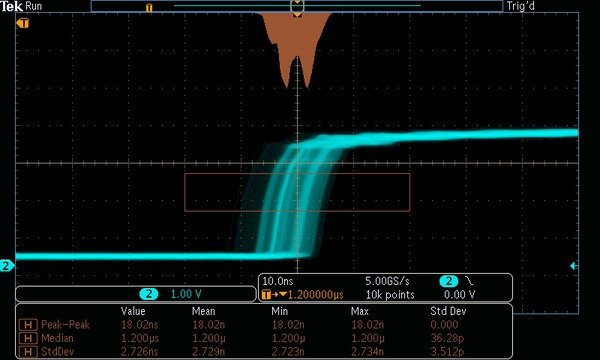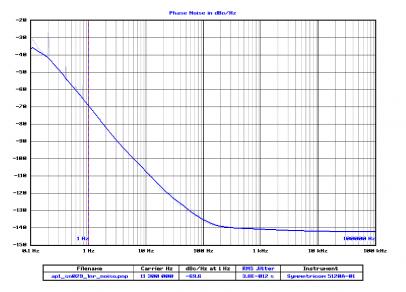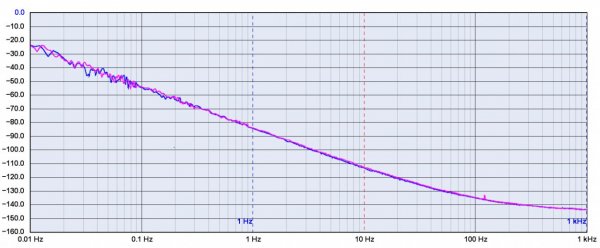"In signal processing, phase noise is the frequency domain representation of rapid, short-term, random fluctuations in the phase of a waveform, caused by time domain instabilities ("jitter").[1] Generally speaking, radio frequency engineers speak of the phase noise of an oscillator, whereas digital system engineers work with the jitter of a clock." - Wikipedia.
So turntable wow and flutter is indeed jitter.
They are interconnected, but the variability doesn't increase and decrease. The variation increases and decreases. All the clock edges progressively move one way relative to the correct time, then move the other way.
The highlighted statement is what I was saying was fundamentally wrong. How can the timing be RANDOM & yet this statement hold true? This implies that there is a connection between the mistimings (all moving in one direction) rather than them arising from the flicker noise of the atomic structure of the crystal slice. Again this is what is fundamentally wrong in your understanding of jitter
You've painted yourself into a corner here. Explain how you can have "close in phase noise" without the frequency variation of the clock containing the components. For example, for phase noise in your "2 to 5 Hz" range, the noise must contain components in the 2 to 5 Hz range. Put in phase terms, the clock timing variations must exhibit long-term periodicity relative to the clock period. The math holds all the way down to DC, which of course is simple "clock drift".
This is the problem that I mentioned already - looking at FFTs can easily lead one's thinking astray - an FFT is a statistical summary of the energy found in the bin frequencies used in the FFT - if a particular bin (like 2-5Hz) has a high energy it will plot as a hill rising out of the floor - it doesn't mean that the clock edges progessively move towards 2Hz & then away from 2Hz, it simply means that over the time measured in the FFT there was more energy found in the 2-5Hz bin than outside it - the oscillator was found to be mistiming in the 2-5Hz range more than 6-9Hz but not en mass as you state - it's purely statistics & nothing to do with the clock's edges all moving one way & then all moving another way.
If you had a dice which was rigged to bias towards a six & you threw it 1000 times, you would see six was the statistically favoured face that showed but in the throwing you wouldn't notice any "moving towards six" when looking at the individual throw.
This diagram should help - it shows a scope shot of the rising edge of a waveform plotted over many cycles & overlaid on top of one another - each individual scope trace would be seen as a solid single line tracing the rising edge but when we overlay multiple such events, instead of a thin solid rising line in the trace we see a broadened trace meaning that the rising edge is not always happening at the same time, it is varying. In the scope trace we see two areas of this broadened trace which are brighter than the surrounding areas - this signifies that there are more lines being traced in these areas than in other, less bright areas - in other words the rising edge timing is wrong by this 2 offsets more than others - it doesn't mean that if we looked at the build up of this scope trace in serial time that we would see the scope trace moving into this region & the trace repeatedly falling in this region one after another for repeated runs & then moving away from this region - we would see no concerted move of the scope trace in this way - it looks random, just like the dice throw
The histogram in brown above the scope trace shows the waveform histogram of a rising edge showing the two peaks in the distribution of edge position (jitter) over time.

One way of looking at jitter is, as the Wikipedia definition said, as random variations in frequency. Imagine that the clock oscillator has a tuning knob that will vary the frequency slightly up or down - like the pitch control on some turntables. Now imagine randomly twirling the knob back and forth. That's jitter.
Yes, but that's not what you described above - your description above suggests that the turning of the knob doesn't happen instantly & that there will be a concerted building of the timing edges towards the final knob position.
And this is the fundamental difference between WOW in analogue & wander in clocks - the WOW is the result of the platter speed ramping towards a wrong timing & then falling away - this is a speed change happening in serial time. Wander in clocks is NOT happening in this way - there's no 'ramping' - one clock tick might be off from the idealised clock, the rising edge happening too soon, the next clock tick rising edge could be too late - it's random - there's no connected timing differences between the clock edges as there is in the analogue WOW phenomena. The WOW in analogue has a mechanical origin & therefore is interconnected in this way, gradually moving towards & then away from the wrong speed. Totally different phenomena to clock jitter even though at a summary level they both look the same.
Remember I said that the summary view may be the same but that the underlying mechanisms can be different?
Does this lead to a different perception? Yes it does & trying to equate analogue WOW to clock jitter is fundamentally wrong in many ways!
Smokester on ASR shares my view too "let's hypothesize that the turntable deviations are due to variations in the rotational velocity of the platter. Then the deviations will be highly correlated because the inertia of the platter won't allow sudden (and random) changes from one end of the distribution to the other. Two sequential measurements (done at or above the Nyquist frequency) can't be very far apart. So they are correlated."











